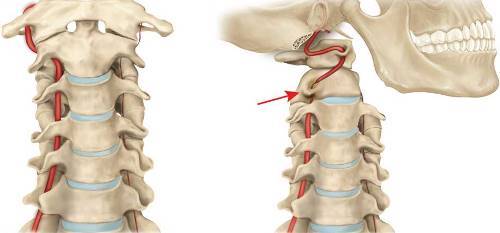The syndrome of “falling drop” or drop attacks (“dropp attack”) is a group of syndromes of the vertebral (spinal) artery. The latter are complex disorders of the vestibular, vascular and vegetative forms, which arise on the background of narrowing of the vertebral artery.
Causal factors
The most important etiopathogenetic the cause of the development of the syndrome are diseases of the cervical spine.
Syndrome of vertebral artery compression of the Genesis most frequently observed. Pathological conditions that contribute to the development of symptoms, mainly ekstrawazalnoe Genesis:
- Osteochondrosis of the vertebral column.
- Motional lability of vertebral segments.
- Cervical spondylosis.
- Intervertebral hernia.
- Neoplastic growths.
- Anomalies of structures of the vertebral system.
- Tonic strain of the cervical musculature.

In other embodiments develops as a result of deformation of the blood vessel is an abnormal structure of the wall of the artery, kinks, or kinking (abnormal vascular tortuosity).
The clinical picture
The symptomatic picture presented by the sudden fall of the patient, but, unlike Unterharnscheidt syndrome, loss of consciousness occurs.
The syndrome is manifested solely by muskulaturnoy loss of postural tone with falling, mostly on the knee joint articulation. After the fall the patient is able to rise ( complains of “sudden podnoshenie feet”).
In the pathogenesis of some experts do not exclude short-term ishemizatsiju caudal division of the trunk, but, unlike the syndrome of Unterharnscheidt, most of the scientists attribute the formation of the paroxysms mostly ishemizatsii that is the cervical area of the spinal cord.
The syndrome of “falling drop” characteristic of a sudden development of severe weakness in the limbs at the time of fast rotation of the head in the side or at the time of tilting the head back. When performing this procedure, the patient instantly falls. Consciousness is not changed, and there is frequently pain in the occipital and cervical areas. After a few minutes misile in the extremities begins to recover. Deep reflexes on the upper extremities are reduced or not is determined in the lower extremities the tendon reflexes were slightly increased, it is possible to identify Babinski reflex on both sides.
After ten minutes or more neurological status recovered to normal values. The acute tetraparesis may be renewed by subsequent turning of the head. They recur with intense degenerative-dystrophic lesions of the cervical portion of the spinal column, in some cases in combination with atherosclerosis of the vertebral arteries have a relationship with transient ishemizatsii cervical vertebral segments.
Diagnostic complex
A paroxysm of syncope diagnosed by a neurologist, often seek advice from vestibulares. The physical examination, occasionally the manifestations of autonomic disorders, in the neurological status is instability in the Romberg, symmetric slight discoordination at the time of execution coordinatory tests.
Echocardiography of the cervical spine is performed in combination with functional tests in two projections. It allows to identify vertebral diseases: spondylosis, low back pain, excessive mobility, and articular subluxation, abnormal structure.
If necessary CT is assigned to the backbone and to evaluate the state of the cerebrospinal tissue and narokoroko used MRI study.
With the aim of identifying possible vascular disorders is REG with functional tests.
Treatment of vertebral artery syndrome
In the case of syncope mode choice (hospital or home) to the severity of the syndrome. To reduce the load on the neck area recommended wearing a collar Schantz.

Also used chiropractic, which is shown to restore vzaimoraschety anatomical structures of the cervical, with the aim of relief of tonic tension of the muscle groups of the neck is recommended postisometric relaxation and myofascial massage.
Drug therapy is mainly of mixed character. The bulk are medications, relieving swelling, which aggravates the compression of the PA (troxerutin, diosmin, etc.). Normalization of hemodynamic functions in PA shows the assignment of pentoxifylline, Vinpocetine, nimodipine, Cinnarizine.
The use of neuroprotective funds aimed at prevention of metabolic disorders in the cerebral tissue, where a high probability of ishemizatsii. In parallel with the described therapy is symptomatic treatment protivomigrenoznami, antispasmodic and muscle relaxant agents, vitamins of group B.
High enough positive result provide physiotherapy treatments (Ultratone and electrophoresis, magniticent, DDT), acupuncture, massage. In the interictal period good effects the execution of therapeutic exercises to strengthen neck muscle groups.




Good information, I really loved reading this.
I don’t understand what you mean
How can they do this?